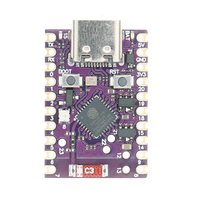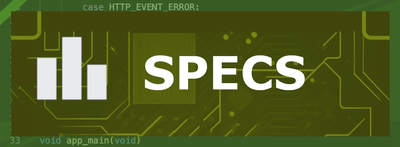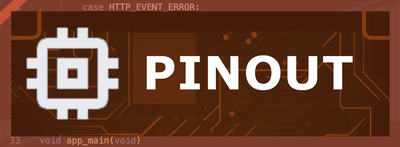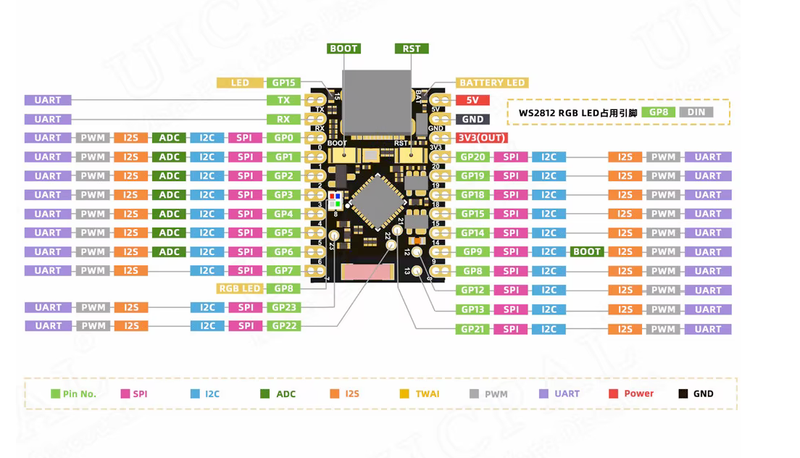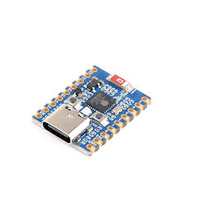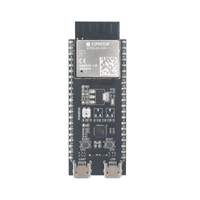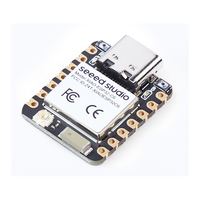ESP32-C6 Super Mini Development Board Pinout and Technical Specifications
Code name: ESP32C6_DEV
ESP32-C6 Super Mini development board is based on esp32c6 microcontroller and uses riscv32 architecture. This development board has a maximum CPU frequency of 160 MHz and a flash size of 4MB.
🛒 Price
📝 ESP32-C6 Super Mini Description
The ESP32-C6 SuperMini is a compact and powerful development board featuring the Espressif ESP32-C6 WiFi 6 and Bluetooth dual-mode chip. With support for IEEE 802.11ax WiFi 6 (2.4 GHz) and Bluetooth 5 (LE) with Bluetooth Mesh, it ensures fast and reliable wireless connectivity.
At its core, the ESP32-C6 SuperMini is powered by a RISC-V 32-bit single-core processor running at up to 160 MHz, offering efficient performance for IoT applications. It includes 512 KB of high-performance SRAM, 16 KB of low-power SRAM, and 4 MB of flash memory, giving your projects plenty of space to run smoothly.
Designed with ease of use in mind, the board comes with a USB Type-C interface for simple programming and connectivity. Plus, its compact form factor makes it ideal for space-constrained applications.
With versatile interfaces (UART, I2C, SPI) and a rich set of GPIOs, the ESP32-C6 SuperMini is a great choice.
🆚 Wondering how the ESP32-S3 SuperMini compares to other SuperMini boards? Check out our full comparison guide to see how it stacks up against the C3, C3 Plus, C6, and H2.
📊 ESP32-C6 Super Mini Specs
Below you can find the specifications of ESP32-C6 Super Mini, such as features, connectivity options, and ESP32-C6 Super Mini technical specs.
✨ Features
- Ultra-small size for embedded applications
- Ultra-low power consumption with low-power working modes
- RISC-V 32-bit single-core CPU running at up to 160 MHz
- 512 KB high-performance SRAM and 16 KB low-power SRAM
- WiFi 6 (802.11ax, 2.4 GHz) with 40 MHz bandwidth support
- Bluetooth 5 (LE) and Bluetooth Mesh support
- USB Type-C interface for programming and connectivity
- Stamp hole design for direct soldering onto PCB
- 11 digital IO pins
- 22 external interrupt pins
- 6 analog input pins
- 11 PWM pins
🛰️ Connectivity
- WiFi: 802.11 ax b/g/n (2.4 GHz)
- Bluetooth: 5.3
- BLE: 5.3
📐 Technical specs
| Microcontroller | esp32c6 |
| Clock Speed | 160 MHz |
| Flash size | 4MB |
| Architecture | riscv32 |
🔌 ESP32-C6 Super Mini Pinout
The ESP32-C6 Super Mini pinout is designed for versatile connectivity in a compact format. The board provides essential power pins such as 5V, 3.3V, and GND for stable power delivery.
It features dedicated communication interfaces including RX and TX for UART, SDA and SCL for I2C, and MISO, MOSI, SCK, and SS for SPI, ensuring seamless integration with peripherals.
For analog input, the ESP32-C6 Super Mini offers ADC pins labeled A0 to A5, supporting sensor applications. Additionally, it features a stamp hole design for direct soldering, providing improved reliability for embedded applications.
⚠️ Pins to Avoid or Use with Caution
Some pins are reserved for critical functions like bootstrapping, JTAG debugging, USB communication, and flash memory operations. Misusing these pins may lead to boot failures, programming issues, USB conflicts, or disruptions in flash storage. Below is a list of pins to avoid or use with caution, categorized for clarity:
- 🛠️ Strapping Pins (Boot Mode & System Behavior) - These pins control boot behavior and flash voltage selection. Pulling them high or low at reset can impact boot mode selection, voltage settings, or debugging access. Avoid altering their state unless necessary.
- 🔗 JTAG Debugging Pins - JTAG is used for low-level debugging and programming. If JTAG is enabled, these pins must remain dedicated to it. Repurposing them as GPIO can disable JTAG debugging features.
- 🔌 USB Communication Pins - These pins are used for USB Serial/JTAG communication. If USB debugging or communication is required, they should not be reassigned as GPIO.
- ⚡ Flash Memory & SPI Pins - Certain GPIOs are hardwired to SPI flash memory and PSRAM. Using them as standard GPIOs may result in system instability, corrupted storage, or boot failure.
- 📡 UART Serial Communication Pins - By default, these pins are used for serial debugging, console output, and firmware uploads. Repurposing them for general I/O may break UART programming or debugging capabilities.
| PIN | Label | Reason | Function |
|---|---|---|---|
| IO4 | MTMS | Used during boot; required for JTAG debugging; flash data in internal-flash models. | 🛠️ Strapping |
| IO5 | MTDI | Used during boot; required for JTAG debugging; flash data in internal-flash models. | 🛠️ Strapping |
| IO6 | MTCK | Required for JTAG debugging; connected to flash clock in internal-flash models. | 🔗 JTAG |
| IO7 | MTDO | Required for JTAG debugging; connected to flash data in internal-flash models. | 🔗 JTAG |
| IO8 | GPIO8 | Determines boot mode; pulling low at reset can prevent normal boot. | 🛠️ Strapping |
| IO9 | GPIO9 | Pulling low on reset forces the ESP32-C6 into download mode instead of normal boot. | 🛠️ Strapping |
| IO12 | USB_D- | Dedicated to USB communication; avoid if using USB functionality. | 🔌 USB |
| IO13 | USB_D+ | Dedicated to USB communication; avoid if using USB functionality. | 🔌 USB |
| IO15 | JTAG_SEL | Controls JTAG input source at boot; avoid altering its state. | 🔗 JTAG |
| IO18 | FSPIQ | Connected to internal flash; using as GPIO can disrupt flash operations. | ⚡ Flash |
| IO19 | FSPID | Connected to internal flash; using as GPIO can disrupt flash operations. | ⚡ Flash |
📌 Key Takeaway:
- Before using any GPIO, check if it is assigned a critical function.
- Avoid using bootstrapping pins unless you're modifying boot behavior intentionally.
- If JTAG debugging is needed, ensure its pins remain free.
- USB and Flash-related GPIOs should remain dedicated unless you disable their default functions.
✅ Pins Safe to use
- 🔹 IO0
- 🔹 IO1
- 🔹 IO2
- 🔹 IO3
- 🔹 IO14
- 🔹 IO20
- 🔹 IO21
- 🔹 IO22
- 🔹 IO23
Unlike restricted pins, these GPIOs are not tied to essential system functions like 🛠️ bootstrapping, 🔌 USB communication, 🔗 JTAG debugging, or ⚡ SPI flash memory, making them the best choices for custom applications and general use.
Why Are These Pins Safe?- Not involved in bootstrapping → These GPIOs do not affect the device’s boot mode or system startup.
- Not linked to flash memory or PSRAM → They won’t interfere with storage or memory access.
- Not dedicated to USB or JTAG → They remain free for general use without affecting debugging or programming.
- No special hardware connections → Unlike some pins that are internally wired to system functions, these remain freely assignable.
🗺️ ESP32-C6 Super Mini External Pins Mapping Functions
Below you can find the ESP32-C6 Super Mini pinout. This development board provides 11 digital IO pins, out of which 22 can be used as an external interrupt pins , 6 as analog input pins and 11 pins have Pulse-Width Modulation (PWM) .
| Pin | Function | ESP Pin | Input/Output | Description |
|---|---|---|---|---|
| 1 | 5V | 5V | POWER INPUT | 5V power input for the board |
| 2 | GND | GND | POWER GROUND | Ground connection |
| 3 | 3V3 | 3.3V | POWER OUTPUT | 3.3V power output for peripherals |
| 4 | TX | TX | TX | TX |
| 5 | RX | RX | RX | RX |
| 6 | IO0 | GP0 | BIDIRECTIONAL | GPIO, ADC pin |
| 7 | IO1 | GP1 | BIDIRECTIONAL | GPIO, ADC pin |
| 8 | IO2 | GP2 | BIDIRECTIONAL | GPIO, ADC pin |
| 9 | IO3 | GP3 | BIDIRECTIONAL | GPIO, ADC pin |
| 10 | IO4 | GP4 | BIDIRECTIONAL | GPIO, ADC pin |
| 11 | IO5 | GP5 | BIDIRECTIONAL | GPIO, ADC pin |
| 12 | IO6 | GP6 | BIDIRECTIONAL | GPIO, ADC pin |
| 13 | IO7 | GP7 | BIDIRECTIONAL | GPIO |
| 14 | IO8 | GP8 | BIDIRECTIONAL | GPIO, RGB LED |
| 15 | IO9 | GP9 | BIDIRECTIONAL | GPIO, Boot |
| 16 | IO12 | GP12 | BIDIRECTIONAL | GPIO |
| 17 | IO13 | GP13 | BIDIRECTIONAL | GPIO |
| 18 | IO14 | GP14 | BIDIRECTIONAL | GPIO |
| 19 | IO15 | GP15 | BIDIRECTIONAL | GPIO, LED |
| 20 | IO18 | GP18 | BIDIRECTIONAL | GPIO |
| 21 | IO19 | GP19 | BIDIRECTIONAL | GPIO |
| 22 | IO20 | GP20 | BIDIRECTIONAL | GPIO |
| 23 | IO21 | GP21 | BIDIRECTIONAL | GPIO |
| 24 | IO22 | GP22 | BIDIRECTIONAL | GPIO |
| 25 | IO23 | GP23 | BIDIRECTIONAL | GPIO |
🗺️ ESP32-C6 Super Mini Pins Mapping Arduino IDE
Below you can find the ESP32-C6 Super Mini pinout. This development board provides 11 digital IO pins, out of which 22 can be used as an external interrupt pins , 6 as analog input pins and 11 pins have Pulse-Width Modulation (PWM) .
| Pin | Analog | Touch | PWM | Other |
|---|---|---|---|---|
| 0 | A0 | |||
| 1 | A1 | |||
| 2 | A2 | |||
| 3 | A3 | |||
| 4 | A4 | SCK | ||
| 5 | A5 | MISO | ||
| 6 | MOSI | |||
| 7 | SS | |||
| 8 | SDA | |||
| 9 | SCL | |||
| 20 | RX | |||
| 21 | TX |
🛠️ Default Tools
| Bootloader tool | esptool_py |
| Uploader tool | esptool_py |
| Network uploader tool | esp_ota |
| Bootloader address | 0x0 |
| Flash mode | qio |
| Boot mode | qio |
| PSRAM type | |
| Maximum upload size | 1280 Kb (1310720 B) |
| Maximum data size | 320 Kb (327680 B) |
The ESP32-C6 Super Mini development board by default uses esptool_py uploader tool, esp_ota network uploader tool for Over-the-air (OTA) uploads and esptool_py bootloader tool. The bootloader starts at address "0x0". Flash mode and boot mode for ESP32-C6 Super Mini development board by default is qio and qio respectively.

